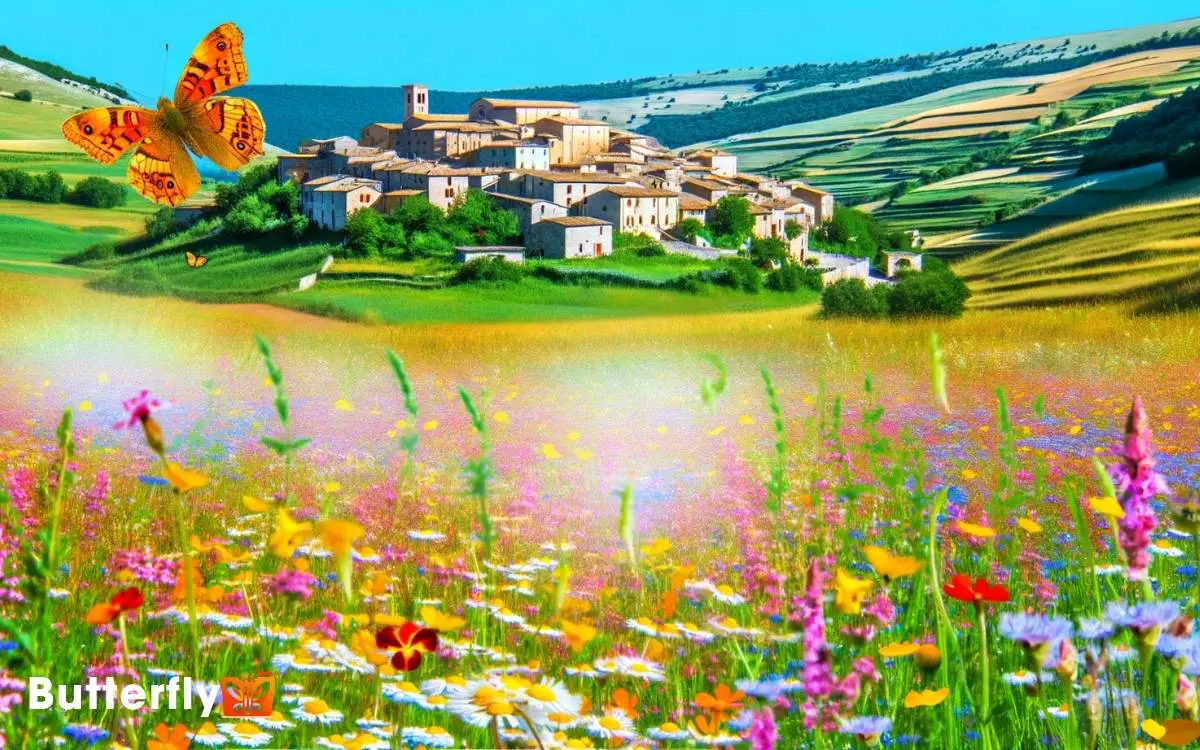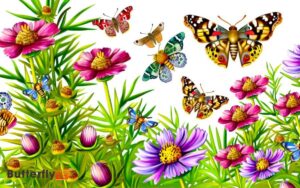How To Say Butterfly In Italian? Farfalla!
When learning how to say ‘butterfly’ in Italian as ‘farfalla,’ it is crucial to pronounce it with a melodic quality. Remember to stress the first syllable and slightly more on the second for rhythmic balance.
Mispronouncing the double ‘l’ can affect the natural flow of your speech, so practice for a smooth, flowing sound.
If you wish to incorporate this charming word into your conversations and delve deeper into its cultural significance, you’re in the right place.

Key Takeaways
Pronouncing ‘Farfalla’
To pronounce ‘farfalla‘ correctly in Italian, start by stressing the first syllable and making sure the ‘r’ is lightly rolled.
- You’ll want to capture the musicality of the language by letting each letter flow smoothly.
- Focus on a gentle touch with the ‘f’ sound, and make certain the double ‘l’ is pronounced distinctly.
- Think of the word as a delicate dance, each letter contributing to the overall harmony.
- Emphasize the melodic quality, as Italian is known for its lyrical nature.
By paying attention to these details, you’ll not only get the pronunciation right but also convey a genuine appreciation for the language’s beauty.
This attention to detail will resonate with your innovative spirit and elevate your linguistic skills.
Phonetic Breakdown
Let’s break ‘farfalla’ into its phonetic components so you can master each sound with confidence.
- Start with ‘far,’ where the ‘f’ is pronounced like in ‘fun’ and the ‘ar’ sounds like ‘are.’
- Next, ‘fal‘ has a crisp ‘f’ followed by ‘al,’ similar to ‘pal.’
- The double ‘l’ in ‘falla’ requires a brief pause, emphasizing the ‘l’ sound, akin to ‘ll’ in ‘bell.’
- Finally, the ‘a’ at the end is short, like ‘a’ in ‘sofa.’
- So, it’s ‘far-fal-la.’
- Practice stressing the second syllable slightly more: far-FAL-la.
- This rhythmic balance will make your pronunciation sound natural and fluid.
Master these steps, and you’ll confidently say ‘farfalla’ like a native.
Common Mistakes
One common mistake when saying ‘farfalla‘ is mispronouncing the double ‘l,’ which can make your speech sound unnatural to native listeners.
You need to emphasize the ‘ll’ as a longer, almost rolling sound. Skipping this essential detail can lead to misunderstandings.
Another pitfall is stressing the wrong syllable. The correct emphasis is on the second ‘a’ in ‘farfalla.’
Be mindful of false friends, too; ‘farfalla’ in Italian means butterfly, not to be confused with similar-sounding words in other languages that have different meanings.
Lastly, watch out for regional accents. While standard Italian pronunciation is widely understood, local dialects can introduce variations that might trip you up. Practice makes perfect, so keep refining your pronunciation.
Usage in Sentences
Now that you’ve mastered the basics, let’s explore how to use ‘farfalla‘ in sentences.
Whether you’re chatting with friends, reading Italian poetry, or teaching kids new words, knowing how to incorporate ‘farfalla’ can be incredibly useful.
We’ll look at everyday conversational examples, literary and poetic uses, and contexts for children’s learning to give you a well-rounded understanding.
Everyday Conversational Examples
In everyday Italian conversations, you might say ‘farfalla‘ when referring to a butterfly, such as in the sentence, ‘Ho visto una bellissima farfalla nel giardino’ (I saw a beautiful butterfly in the garden).
Imagine you’re at a park and you want to share an observation: ‘Guarda quella farfalla colorata!’ (Look at that colorful butterfly!).
Or, if you’re discussing a nature hike, you might say, ‘Abbiamo visto molte farfalle lungo il sentiero’ (We saw many butterflies along the trail).
These examples show how ‘farfalla’ can effortlessly slip into your daily dialogues. Whether you’re marveling at nature’s beauty or recalling a pleasant outing, incorporating ‘farfalla’ into your Italian vocabulary adds a touch of poetic charm to your speech.
Literary and Poetic Uses
Many Italian poets and writers have admired and captured the ethereal beauty of ‘farfalla‘ in their works, using it as a symbol of transformation, freedom, and ephemeral moments.
You might find ‘farfalla’ fluttering through the verses of Giovanni Pascoli, where it often represents fleeting joy. In Italo Calvino’s prose, the butterfly’s delicate wings mirror the fragility and beauty of human experiences.
When you read these works, notice how ‘farfalla’ is used to evoke a sense of wonder and transience. Embracing ‘farfalla’ in your own writing can infuse it with a lyrical quality that speaks to the human condition.
Try using it to symbolize change or the fleeting nature of beauty in your innovative narratives.
Children’s Learning Contexts
Teaching the word ‘farfalla’ to children can be a delightful experience, especially when you incorporate colorful illustrations and engaging activities that capture their imaginations.
You can create a dynamic learning environment by using sentences that place ‘farfalla’ within relatable contexts, such as nature walks or art projects.
Here are some sentences to practice:
| English Sentence | Italian Sentence | Activity Idea |
|---|---|---|
| Look at the butterfly. | Guarda la farfalla. | Nature walk |
| The butterfly is colorful. | La farfalla è colorata. | Drawing |
| I see a butterfly in the garden. | Vedo una farfalla nel giardino. | Garden exploration |
| Catch the butterfly! | Prendi la farfalla! | Outdoor play |
| Butterflies love flowers. | Le farfalle amano i fiori. | Flower planting |
Using these sentences in fun, interactive ways helps children remember the word ‘farfalla’ effortlessly.
Regional Variations
You might be surprised to learn that the way Italians say ‘butterfly’ can vary quite a bit depending on the region. In standard Italian, the word for butterfly is farfalla, but some regional dialects have their own unique variations. For example, in Sicilian, it’s palumma, which interestingly also means dove. If you’re curious about different languages, you might also want to know how to say butterfly in French—it’s papillon!
In Northern Italy, dialects might use terms that sound different from the standard ‘farfalla,’ while Southern Italy has its own unique expressions.
Understanding these regional variations can give you deeper insights into Italy’s rich linguistic diversity.
Northern Italy Dialects
In Northern Italy, the word for ‘butterfly’ can vary greatly across different dialects, offering a fascinating glimpse into the region’s rich linguistic tapestry. Each dialect provides a unique flavor to the term, reflecting local culture and history.
Here’s how you can say ‘butterfly’ in three Northern Italian dialects:
- Milanese Dialect: Farfàla
- Venetian Dialect: Parpajòla
- Piedmontese Dialect: Parpaja
These variations highlight the diversity within Northern Italy, where even a single word can tell a story of regional identity. Exploring these dialects not only enriches your vocabulary but also deepens your understanding of Italy’s intricate cultural mosaic.
Let’s dive into these linguistic treasures and appreciate the beauty of regional expressions.
Southern Italy Terms
Southern Italy’s vibrant tapestry of dialects offers a fascinating array of terms for ‘butterfly,’ each reflecting the region’s unique cultural and linguistic heritage.
In Naples, you’ll hear ‘farfalla,’ similar to standard Italian. But venture into Sicily, and you might encounter ‘palumma,’ a term that intriguingly also means ‘dove.’
Calabria has its own twist with ‘paparina,’ demonstrating the linguistic diversity even within small regions. These variations aren’t just words; they’re cultural markers, each imbued with local history and identity.
Cultural Significance
Butterflies, or ‘farfalle’ in Italian, hold a deep cultural significance in Italy, symbolizing transformation, beauty, and the fleeting nature of life. You’ll find that these delicate creatures are woven into the fabric of Italian culture in fascinating ways.
Here are three key aspects worth exploring:
- Art and Fashion: Italian designers often use butterfly motifs to evoke elegance and grace in their creations.
- Festivals: Traditional Italian festivals sometimes feature butterfly-themed decorations, celebrating renewal and rebirth.
- Cuisine: The shape of ‘farfalle’ pasta, resembling a butterfly, connects the culinary arts to this symbol of beauty and change.
Understanding these elements enriches your appreciation of how deeply the butterfly influences Italian culture.
‘Farfalla’ in Literature
You’ll find that the influence of ‘farfalle‘ extends beyond visual and culinary arts, permeating Italian literature with rich symbolism and poetic metaphors. In Dante’s ‘Divine Comedy,’ the butterfly represents the soul’s transformation and eternal journey.
Italian poets often explore the fragile human condition, with butterflies embodying fleeting moments of clarity and enlightenment.
When reading contemporary Italian literature, you’ll notice authors like Elena Ferrante incorporating butterflies into narratives as symbols of personal growth and metamorphosis.
The elegance of ‘farfalla’ seamlessly bridges the sensuality of language with profound existential themes, making it a versatile and evocative literary device.
Fun Facts
Did you know that the Italian word for butterfly, ‘farfalla,’ isn’t only linguistically beautiful but also holds numerous cultural and historical curiosities?
Here are some fascinating facts to tickle your curiosity:
- Culinary Delight: In Italian cuisine, ‘farfalle’ is a type of pasta shaped like little butterflies. It’s often used in salads, giving dishes a whimsical touch.
- Symbolism: In Italian art and folklore, butterflies symbolize transformation and the soul, often appearing in Renaissance paintings to signify rebirth and spiritual awakening.
- Etymology: The word ‘farfalla’ traces back to the Latin ‘papilio,’ which also means butterfly. This reflects the deep linguistic roots connecting Italian to ancient languages and cultures.
These tidbits reveal how ‘farfalla’ flutters through various aspects of Italian life.
Practice Tips
One effective way to master saying ‘farfalla‘ in Italian is to break the word down into its syllables: far-fal-la. By doing this, you can focus on pronouncing each part accurately.
Use a mirror to watch how your mouth moves and compare it to native speakers. Record yourself and play it back to catch any mistakes.
Incorporate ‘farfalla’ into sentences to build context, like ‘Ho visto una farfalla’ (I saw a butterfly).
Engage with Italian media, such as podcasts and videos, to hear the word in natural conversation.
Conclusion
In your journey to master ‘farfalla,’ you’ve discovered not just a word, but a whole new cultural treasure trove.
Don’t just understand it immerse yourself in it! Practice until it flows off your tongue as effortlessly as a butterfly’s flight.
With these tips, you’ll speak Italian so well, your friends will think you were raised in Rome.
Immerse yourself in the world of ‘farfalla’ and let your linguistic skills soar to unimaginable heights!






